Widest tires on 1968 Corvette (Stock or modified) and 69-82 Corvettes
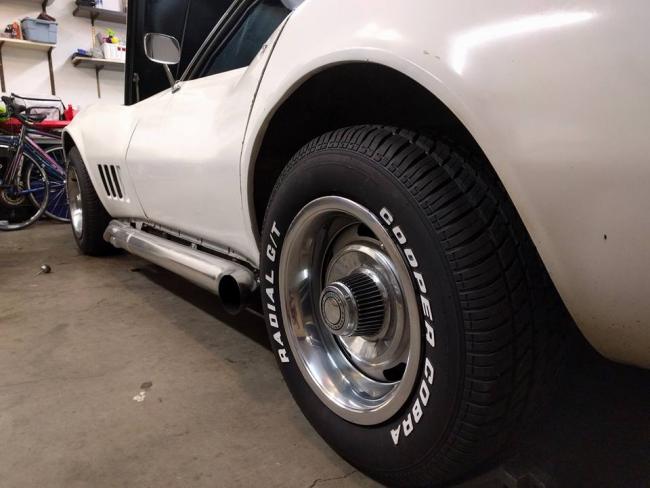
Who doesn't want big fat tires on their muscle car? More grip, better braking, and a big improvement for putting power down. Add on that muscle car big grippy tire look, it's easy to see why people go chasing wider tire configurations! The 1968 Corvette however is a one year only car in a lot of regards, and has a lot of specific limitations to know. Be forewarned, there's a lot of sporadic information out there on how to upgrade your C3 corvette. but very little of it is specific to the 1968 Corvette. For example, the simplest article on it is "More Bite for Old Sharks" which contains information on how to make the most of OEM sized wheels. Unfortunately, the information contained therein is specific to 69 and above Corvettes with 8" wheels, and fails to tackle some unique aspects of the bodywork on 1968, such as the front not being able to handle 255 series tires. Everything else has been largely procured from my experience first and internet forums second, which are of course a bit unreliable but do contain many first hand experiences with these cars.
Here is my compilation of wheel and tire options for your 1968 Corvette, and 69-82 Corvettes:
- With ZERO modifications you can run 235's front and rear on the OEM 7" wide wheels. A decent gain for no work at all, but not all that impressive really. The limiting factors to go larger than this are the parking cable bracket on the rear, and clearance with the front fender up front. See picture below of my pinky being all the space between a 235 and the front fender. With a 245 that space goes down to a flat head screw drivers distance. This is all of course complicated by having notably more clearance on the other side... perhaps indicating something is up with my Corvette specifically, even though the entire chasis has now been redone. I'm personally comfortable with this much space as I would not expect overall tire circumference to change.
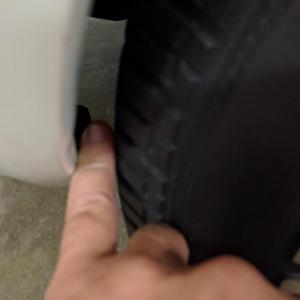
- If you relocate the parking brake bracket you can also do 245's on the 7" OEM wheels in the rear, and 245's up front with no modifications. I went this route at first on my Corvette. Some may argue this isn't nescessary for the rear and can be run zero modifications, but I didn't even have a pinky fingers worth of clearance between the sidewall and the parking brake bracket, which is a sidewall slashing piece of metal. When I tried the bracket relocation process myself, it was quite the hassle. I wound up just cutting the bracket off since I didn't have a working parking brake at the time and planned to fix them along with get new double offset trailing arms later. See picture below for relocation. Please note, this picture is a generic photo from a forum, and not an example of my fabrication work.
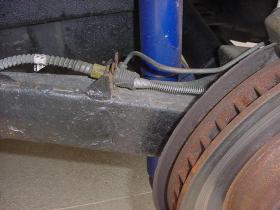
- You can run 255/60R15 in the rear, ideally upgrading to 15x8" wheels. This is also somewhat debatable, as Cooper tires claims a smallest wheel width for the 255/60R15 as 7", but recommended is 7.5". I personally wouldn't expect these to feel or handle great at 7", but you can get away with this. This is also supposedly without any modifications, although again I'd not put any confidence in the rear parking brake bracket clearance. I am not confident that the front can be done on a 1968 without trimming the fender, contrary to the article above. See picture above of clearance with a 235. Even with modifications making 255 work up front, keep in mind 255/60R15 is the max possible in front in front due to running into steering components that aren't easily relocated.
- You can run double offset trailing arms with a 275/60R15 in the rear on 8" wheels (with 4.5" backspacing), ontop of the previously mentioned wider tire's up front. Starting to get pretty meaty! This is the choice I currently have on my 68 corvette. The rear tires though will be a 28" circumference, which is close to OEM size. On 8" wheels the tires are on the ideal rim width for their size, and fill in the wheel well quite nice. This looks great on my Corvette, and with the extra .5" of backspacing (OEM 69-84 wheels are 4" backspacing) works well to bring the wheels inboard. The double offset trailing arms also help ensure the arm is never connected with, and the spring, which is shortened, is suitably far away from the tires.
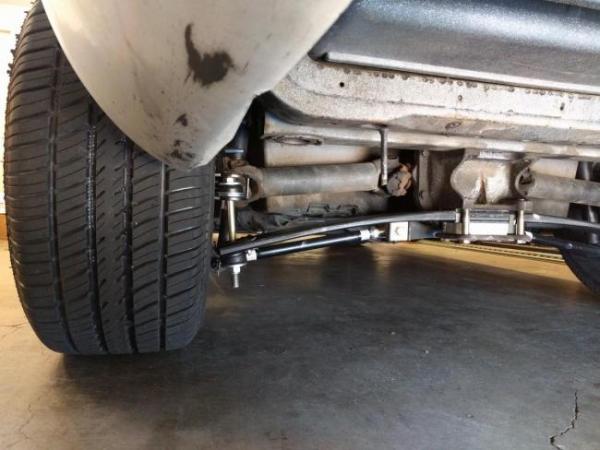
- With fender flares, you can run 295/60R15's on a 15x10 wheel, or 275/60R15's with OEM/Stock 69+ C3 15x8" rally wheels. This is per a conversation with Vansteel and some basic measuring. The 1968 Corvette rear wheel well is 11" deep (inner fender to frame). The section width of a 295/60R15 is 12", so there's 1 inch of tire that will make contact with the body. Heavy duty tire always beats fiberglass body. You can get around this by adding fender flares to increase the depth of the wheel well, but the look starts to get a bit cartoony and batmobile looking, so I stopped above at step 4.The 275/60R15 is 10.75" wide, so it fits, but with the standard 4" backspacing it will likely hit the lip of your wheel well causing body damage, hence needing the wheel I have.
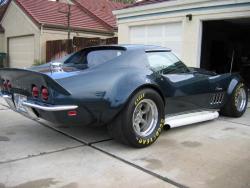
- You can go with larger diameter wheels and modern tires. The 15" tire choices aren't exciting as they're all relatively old school and are fairly tired tread designs in general. I personally chose to go with 15"s for the classic look aspect and wanting white letter tires. I do struggle still though with having a 118mph top speed rated tire on a 400+hp vehicle, as that just doesn't sound wise. That said, I generally just go 60mph and go get ice cream in this thing, haha. What you could get are 18" wheels like the Rev Classic 107's and run 245 up front and 275 in the rear, or go even larger if you want in the rear if you so desire. This does require relcoating the parking brake bracket. If you want to go even wider/larger, just like with 15"s the rear transverse leaf spring will be the biggest issue, followed by the frame for backspacing, the wheel well (flares being needed to widen) and the trailing arms could become a factor as well potentially. Also note that a 245 and 275 low aspect tires on 18" wheels have a wider tread pattern than the equivelant width tires on 15 inch wheels. Because the sidewal is notably stiffer, they can have a notably wider contact patch and thus you get more tread on the ground for your money, along with superior tire technology and Z-rated top speeds.
- Another option for even wider rear tires is to redo the rear frame and swingarm mounting points to be much skinnier. Also known as "tubbing". The rear frame and the tub (fiberglass body behind the driver) becomes the limiting factor on further backspacing rear wheels and keeping large tires inboard of stock perimiter bodywork. This also requires changing out the rear of the Corvette body itself underneath. It's a fair bit of work, but if 295 just wasn't cutting it or you want 295 without fender flares... go for it! I've not considered this option at all as it requires fairly significant modification and customization. It also tends to be more of a specific thing for drag racers than street cars.
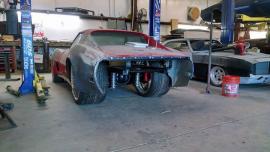
- Go wide body. An article in Vette Magazine (Volume 41, Number 05, May 2017) titled "Top-down Cruising in a Widebody 1968 Corvette Convertible) featured a C3 where a shop went widebody, and actually widened the whole corvette body a foot. I think the quote in their from the designer saying "fender fares are not widebody" properly sums up how excellent this modification is. This let the owner run giant size tires in the rear, with 335/30R20's back there. Incidentally they only ran 245/40R18's up front, holding the 245 size as max for the front it would seem.. The cost for this was surely astronomical, but the person who did it owned a shop so... I'm sure it was no big deal from them, but out of my tax bracket for sure!

What tires are currently on my 1968 Chevy Corvette?
Short version: See step 4 above. 245/60R15 front on 69+ 15x8" wheels, 275/60R15 on 15x8" aftermarket steel rally wheels with 4.5" backspacing, along with Vansteel double offset trailing arms and shortened spring.
Long Version: When I got the Corvette, the tires on it were older than I was (30 at the time) so they had to go. I picked up some cooper Cobra's and ran 215's in the front, and 235's in the rear. These were the tire sizes my dad ran (at least in the rear), and 215/70/15 was the OEM size to my understanding, so I went with 215's in front with a slightly reduced sidewall height to keep them smaller than the rear tires. After doing a bunch of research though and finding out all of the above, I settled on moving the 235/60's up to the front, and replacing the 215/65's with 245/60's and placing them in the rear temporarily. This provided a notable tread width gain in the front in the rear, while allowing me to retain 15" tires and thus keep that classic white lettering tire look for a while longer. The ride is notably improved, as the smaller initial sizes I mentioned had the car feeling rather vague. With this combination however I noticed significant improvement with spirited driving on country roads. When I got around to addressing the rear chasis I moved the 245/60R15 from the rear of the corvette up front on the OEM 15x7" wheels, and then went with 275/60R15 on 15x8" aftermarket steel rally wheels with 4.5" backspacing, all mounted up with Vansteel double offset trailing arms and shortened spring.
Just how much does altering the tire sizes matter for tread width?
Good question! Here are my numerical comparisons for you to analyze for yourself. Keep in mind my "original" tire sizing is based off of P215/65R15 on cooper Cobra Radial GT's (my tire of choice in OEM sizing). Also note I did not compare all possibilities from above. These are just the options i personally found reasonably worthy of considering as the most tire for the least amount of modification.
Cooper Cobra Radial GT's on 7" wide wheels (Largest size on OEM wheels without expensive modifications).
| Tire | Tread Width (new) | Tread Width (original) |
| Front (245/60R15) | 7.99 | 6.81 |
| Rear (245/60R15) | 7.99 | 6.81 |
| Total gain | 17.33% gain in tread width over original. | |
Cooper Cobra Radial GT's on 8" wide rear wheels, with double offeset trailing arms.
| Tire | Tread Width (new) | Tread Width (original) |
| Front (245/60/R15) | 7.99 | 6.81 |
| Rear (275/60R15) | 8.9 | 6.81 |
| Total gain | 24% gain in tread width over original. | |
Summimoto HTRZ III's on 18x8 and 18x9.5" rev classic 107 wheels.
| Tire | Tread Width (new) | Tread Width (original) |
| Front (245/40ZR18) | 8.6 | 6.81 |
| Rear (275/40ZR18) | 9.8 | 6.81 |
| Total gain | 35% gain in tread width over original | |
Notice the tread width steps up notably on the lower sidewall tires on the 18" wheels. It steps up to the point a 245/40ZR18 compares to the 275/60R15! Despite their total width being similiar, lower aspect ratio tires put more effective tread down due to not having to account for as much sidewall flex, and thus being able to run a wider tread.
So there you have it. At little expense you can gain 17.33%, as I did. From there, you can pick the route I went (remaining with 15" wheels) and get 24%, which sounds miniscule but looks quite significant without appearing like a matchbox car and feels great. From there, you can go modern and gain 35%, which I can only imagine feels that much better. That said, my current configuration yields a 24% gain and has me grinning ear to ear every time I jump on the pedal and feeling confident around turns, so I'm happy.
How does cost factor into the choices being made here?
Cost is indeed a factor. The cheapest is just 235's all around, at just the cost of tires. Next up is parking bracket relocation, which even with a shop doing the work will be cheap to accomplish. Then you can do 255's in the rear. Everything from there starts to get relatively spendy.
If you're fairly handy and your trailing arms are sorted, going with 18" wheels prevents you from having to do anything involving that. Even if you aren't handy, a shop should be able to do the work needed on the cheap. However, most owners of a 50+ year old vehicle will NOT have their trailing arms sorted and would be advised to redo the bushings at lest, if not outright repair them if you live in a rusty region.
From there, the cost of trailing arms and springs are the big factors for remaining with 15" wheels. The 275 rear 15" wheel configuration requires $520 for a pair of double offset trailing arms along with a customized fiberglass spring at $250. Add in the cost of 2x extra wheels ($120 approx.) as well. By comparison, the 275 18" wheel configuration requires just redoing the rear trailing arm, or replacing them outright for $210 in parts. With the Rev classic 107's, in polished aluminum with center caps, you're looking at $1100 approximately. Keep in mind labor and alignment costs when replacing trailing arms, no matter if they are offset or OEM.
Next up are tires. 245/60R15's are about $270 installed, and the rear 275s are $285 installed. $555 all said and done, with better deals out there as well probably. The Summimoto HTRZ III's are around the same at $600 mounted to the aforementioned wheels.
So the total approximation for the 15" option would be approximately $1675. The cost approximation for the 18" wheels is $1910. The price difference there isn't massive, and the $210 for major improvements to handling and performance along with a wider overall tire width on the ground is hard to argue. However, it does violate the classic look, for a gain that may just be in vast excess of what your car needs. I know mine feels quite grippy on the 245 and 275 tire combination.
As with all things, your mileage may vary! Enjoy your Corvette and best of luck with finding the tire combination that works for your build!